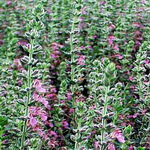| Common Name: |
Wall Germander |
| Botanical Name: |
Teucrium chamaedrys |
| Genus: |
Teucrium |
| Family: |
Lamiaceae |
| Native Location: |
Europe and SW Asia |
| Cultivation: |
Light, well-drained, neutral to alkaline soil in dry or stony soil in sun. Cut off dead flower spikes to encourage bushy new growth. |
| Propagation: |
By seed sown when ripe; by division in spring; by softwood or semi-ripe cuttings in summer. |
| Harvest: |
Plants are cut when flowering, and dried for use in infusions and liquid extracts. |
| height: |
10-24cm (4-10in) |
| Width: |
10-42cm (4-10in) |
| Hardiness: |
Z5-9 |
| Parts Used: |
Whole plant, leaves |
| Properties: |
A bitter, astringent, anti-rheumatic herb that reduces inflammation, stimulates the digestion, and lowers fever. It has antiseptic, diuretic, and decongestant effects. |
| Medicinal Uses: |
Internally for loss of appetite, gall bladder and digestive disorders, summer diarrhea in children, gout, rheumatoid arthritis, nasal mucus, and bronchitis; also to encourage weight loss. Externally for gum disease, skin eruptions, and injuries (including snakebite). Combined with Apium graveolens, (See, Wild Celery), Filipendula ulmaria, (See, Meadowsweet), and Guaiacum officinale (See, Lignum Vitae) for rheumatoid arthritis; and with Achillea millefolium (See, Yarrow) and Apium graveolens (See, Wild Celery) for gout; and with Lobelia inflata (See, Indian Tobacco) and Marrubium vulgare (See, Horehound) for bronchitis. |
| Warning: |
May cause liver damage and is subject to a voluntary ban by practitioners in some countries, notably in France |
| Economic Uses: |
Leaves are used to flavor liqueurs, vermouths, and tonic wines. |
| Bibliography: |
Encyclopedia of Herbs by Deni Brown. Copyright © 1995, 2001 Dorling Kindersley Limited. pg 385.
|

